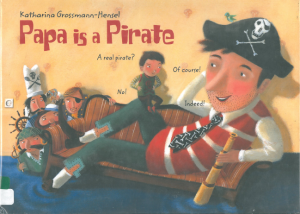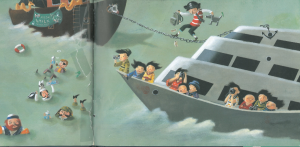Author/ Illustrator: Katharina Grossmann-Hensel
Publishing Information: North-South Books Inc., 2009.
Number of Pages: 24
Genre: Fiction, Picture book


Analysis:
The little boy’s father makes up a story about himself being a pirate. He depicts his life on the ship to his son. He tells the little boy what pirates eat on board and how they send messages by floating them off in bottles. At first the little boy is skeptical about the story his father tells him. But after his father’s vivid description, the boy finally believes that his father really is a pirate.
The text functions as a window for children to look at what pirates’ life is like on board. It is an interesting book which gives children enough space for imagination. The book includes a lot of details which makes the whole tale more reliable. For example, when they are talking about the language usage on board, Papa says, “While Daffy Dan was scrubbing the deck, Petey squawked,’Avast there, ye landlubber! Yo ho ho!’” (P. 6). Another example is that Papa says to the little boy, “I sleep out under the stars. They are the best compass and guide my way” (P. 15). When Papa is telling the story, not only does he describes the plot, he also explains each of his actions. The other advantage of this book is that, in the story, the little boy’s mother is portrayed as a pirate as well. Papa tells the little boy that Mom could be both a princess and a pirate (P. 18). Gender discriminations are eliminated.
One thing I found the book problematic is that all of the characters in the book are white. Children should learn about diversity of different races in literature. Although the boy’s mother is also a pirate, males still exist as rescuers through the story. In the images on page 17 and 18, Papa is illustrated as tall and strong while Mom is small and weak.
Perceptually, the book uses various kinds of colors to depict the compact plot development. The pictures are not framed so that readers can better put themselves in the story. When they are trapped in the desert, all the characters are facing right which conveys a sense of less security. But after they are rescued and heading back home, the ship is moving towards left which demonstrates an increasing sense of security. Structurally, text and images do not overlap. Ideologically, the book teaches children to be brave when facing difficulties.
